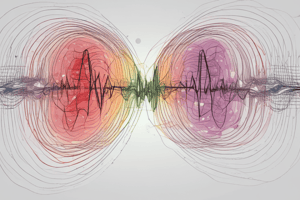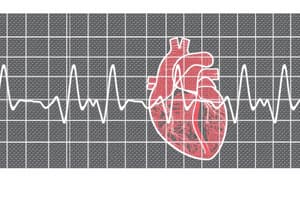Podcast
Questions and Answers
Which equation relates the three standard limb leads?
Which equation relates the three standard limb leads?
- II = I - III
- aVR + aVL = aVF
- I = II + III
- II = I + III (correct)
A positive deflection appears in a lead if the wave of depolarization spreads away from the positive pole of that lead.
A positive deflection appears in a lead if the wave of depolarization spreads away from the positive pole of that lead.
False (B)
What does the P wave represent in an ECG?
What does the P wave represent in an ECG?
Atrial depolarization
The QRS complex represents __________.
The QRS complex represents __________.
Match the following leads with their description:
Match the following leads with their description:
How many precordial leads are there in a standard 12-lead ECG?
How many precordial leads are there in a standard 12-lead ECG?
Monitor leads record heart activity continuously for short periods.
Monitor leads record heart activity continuously for short periods.
What initiates the P wave in an ECG?
What initiates the P wave in an ECG?
What is indicated when the R wave size increases in the chest leads?
What is indicated when the R wave size increases in the chest leads?
The initial small r wave in lead V₁ represents the right-to-left spread of septal stimulation.
The initial small r wave in lead V₁ represents the right-to-left spread of septal stimulation.
What happens during the first phase of normal ventricular depolarization?
What happens during the first phase of normal ventricular depolarization?
Lead V₆ typically shows a _____ complex.
Lead V₆ typically shows a _____ complex.
In a horizontal QRS axis, which leads show qR complexes?
In a horizontal QRS axis, which leads show qR complexes?
Match the following leads with their description of complex:
Match the following leads with their description of complex:
The R waves and S waves being equal indicates a transition zone.
The R waves and S waves being equal indicates a transition zone.
What occurs during the second phase of normal ventricular depolarization?
What occurs during the second phase of normal ventricular depolarization?
Which of the following statements about ECG leads is true?
Which of the following statements about ECG leads is true?
Lead I measures the voltage difference between the left arm and right leg.
Lead I measures the voltage difference between the left arm and right leg.
What is the main purpose of the 12-lead ECG?
What is the main purpose of the 12-lead ECG?
Unipolar leads measure the voltage at one location relative to _____ potential.
Unipolar leads measure the voltage at one location relative to _____ potential.
Match the following leads with their corresponding general description:
Match the following leads with their corresponding general description:
What is the function of Einthoven's Triangle?
What is the function of Einthoven's Triangle?
The chest leads primarily record electrical activity in the frontal plane.
The chest leads primarily record electrical activity in the frontal plane.
Name one advantage of ambulatory monitoring.
Name one advantage of ambulatory monitoring.
Lead II measures the voltage difference between the _____ leg and the right arm.
Lead II measures the voltage difference between the _____ leg and the right arm.
Flashcards
Electrocardiography Principles
Electrocardiography Principles
ECG principles determine how depolarization waves affect lead readings, creating positive, negative, or biphasic deflections.
Unipolar Leads
Unipolar Leads
Unipolar leads measure voltage at one point relative to a neutral point (zero potential): aVR, aVL, aVF.
Biphasic Deflection
Biphasic Deflection
When the mean depolarization path is perpendicular to a lead, resulting in an RS or QR deflection pattern.
P Wave
P Wave
Signup and view all the flashcards
QRS Complex
QRS Complex
Signup and view all the flashcards
Ventricular Depolarization (Phase 1)
Ventricular Depolarization (Phase 1)
Signup and view all the flashcards
Ventricular Depolarization (Phase 2)
Ventricular Depolarization (Phase 2)
Signup and view all the flashcards
Chest Leads
Chest Leads
Signup and view all the flashcards
Normal R-wave Progression
Normal R-wave Progression
Signup and view all the flashcards
Transition Zone
Transition Zone
Signup and view all the flashcards
Normal Chest Lead V1
Normal Chest Lead V1
Signup and view all the flashcards
Normal Chest Lead V6
Normal Chest Lead V6
Signup and view all the flashcards
ECG Axis
ECG Axis
Signup and view all the flashcards
Normal ECG
Normal ECG
Signup and view all the flashcards
Horizontal QRS Axis
Horizontal QRS Axis
Signup and view all the flashcards
ECG Leads
ECG Leads
Signup and view all the flashcards
Vertical QRS Axis
Vertical QRS Axis
Signup and view all the flashcards
Bipolar Leads
Bipolar Leads
Signup and view all the flashcards
Lead I
Lead I
Signup and view all the flashcards
Lead II
Lead II
Signup and view all the flashcards
Einthoven's Triangle
Einthoven's Triangle
Signup and view all the flashcards
Unipolar Leads
Unipolar Leads
Signup and view all the flashcards
aVF Lead
aVF Lead
Signup and view all the flashcards
12-Lead ECG
12-Lead ECG
Signup and view all the flashcards
Chest Leads
Chest Leads
Signup and view all the flashcards
Frontal Plane
Frontal Plane
Signup and view all the flashcards
Study Notes
ECG Leads
- ECGs are used to measure electrical currents produced by the heart
- The body acts as a conductor of electricity, allowing electrodes placed on the arms, legs, or chest to detect heart voltages
- 12 standard ECG leads are used to record voltage differences between electrodes on the body
- Leads are organized into extremity (limb) and chest (precordial) leads
- Extremity leads measure voltage differences between limbs
- Bipolar leads (I, II, and III) record voltage differences between pairs of limb electrodes (e.g., left arm and right arm for Lead I)
- Unipolar leads (aVR, aVL, and aVF) measure voltage differences relative to a central point in the body
- Chest leads measure voltage differences at various locations on the chest wall
- Standard arrangements of electrodes on the body (arms and legs) are important for accurate readings
- Placement of electrodes are important for patient care and considerations
- Additional leads may be necessary in some cases (e.g., in amputees or those with casts)
- The 12 leads are all tuned to the same event (P-QRS-T cycle)
Extremity (Limb) Leads
- Bipolar leads record voltage differences between two electrodes (I, II, or III)
- Unipolar extremity leads measure voltage relative to a central point
- Unipolar leads are "augmented" (50% higher) for easier reading on the ECG
- The electrodes are placed on wrists and ankles for convenience
Chest (Precordial) Leads
- Chest leads record electrical activity at specific positions on the patient's chest
- Precordial leads are unipolar leads, measuring voltage at a single point relative to a central point
- The leads provide a three-dimensional view of cardiac electrical activity
- Accurate positioning of electrodes is critical to ensure accurate readings, particularly in females due to breast tissue
- Electrode placement is guided by anatomical landmarks like the angle of Louis
- Understanding lead placement is essential for clinical practice
Studying That Suits You
Use AI to generate personalized quizzes and flashcards to suit your learning preferences.




